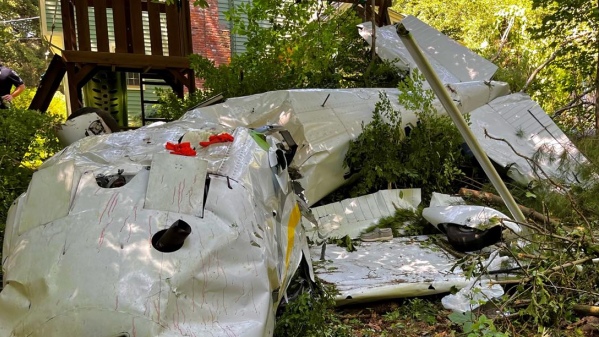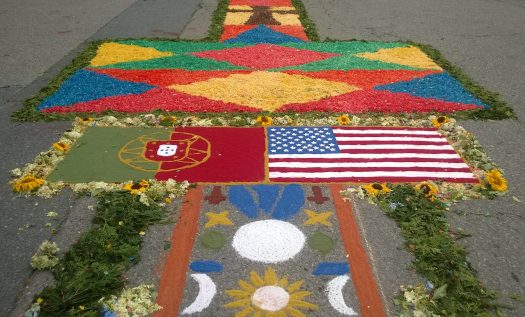
“Get the heck up, my dad is going to kill you!”
My mind starts to rush. I’ve been dating my girlfriend for just over two years and the last thing I want to do is screw things up with her dad, particularly during the week that I am vacationing in his hometown for the first time, at his home no less.

“Did he find out that I drooled over his second-favorite pillow?”
I frantically ask my girlfriend.
“You did what!?” she exclaims.
“Does he know you snuck into the guest room last night? Oh god, do you think he heard us?”
“No, you moron! He needs you to go help him. They’re decorating the streets.”
Relieved my life had been spared, I was fully clothed and on my way to Eugenia Street within 10 minutes. As I neared my destination, I observed an 8½” x 11” flyer duct-taped to a telephone pole.
NO
PARKING
PARADE
ROUTE
Senhor da Pedra Feast
Per Order
New Bedford P.D.
I turned left and suddenly found myself on Eugenia Street, a residential street on New Bedford’s ‘North End’ spanning about 2,900 feet. The city’s heavy Portuguese influence was immediately apparent, as every third or so house was proudly sporting a red and green flag containing a round yellow emblem.
“Nice of you to show up!” my girlfriend’s dad shouted from a distance.
He was in the middle of the street along with another dozen-and-a-half people. I should have been formulating an excuse to justify my two-hour tardiness, but I was too busy witnessing the well-oiled machine before me. Men and women, kids and seniors, friends and strangers, all working in unison. One shoveled dyed woodchips into plastic totes while another two evenly distributed the supply along the street. Burly men strategically placed life-sized wooden stencils along the street as a gang of ten diligently worked to fill in the triangular and rectangular outlines under the guidance of the ‘Director of Colors.’
“This is my daughter’s boyfriend. He’s from Miami. Ele é cubano. Fala espanhol.”
Simon Farias had introduced me to the Portuguese contingent, and seconds later I was scooping handfuls of yellow woodchips, and green, and brown, and blue, and red, and orange. Twenty minutes later I was feeling sluggish and asking Mr. Farias for coffee.
“Coffee? Yeah, come with me,” he uttered with a grin, as we started walking towards his parents’ house, located right on Eugenia Street and in the heart of the festivities to come.
Upon entering the home I observed Mr. Farias’ old lady sitting on the left side of the living room couch, his old man on the right side positioned in his recliner. A double-cheek kiss and handshake later I was at the kitchen counter hoping to get my caffeine fix when an unmarked red ceramic bottle suddenly appeared.
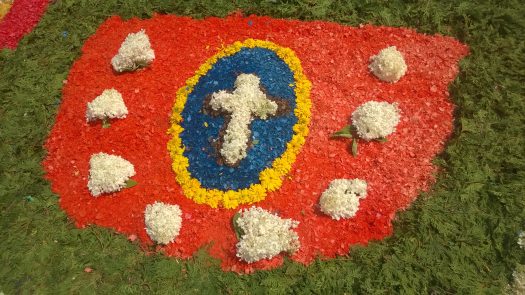
I had a question for Mr. Farias but it never came to fruition, as the three ounces of homemade moonshine that burned past my esophagus did an admirable job of clarifying any uncertainties I may have had.
“It’s good, no?” Mr. Farias asked rhetorically.
My fix was complete, and I was back on the clock transporting totes and getting paint under my fingernails. And perhaps it was the alcohol effect, but all of a sudden the dozen-and-a-half people didn’t seem to be working as hard. Surely, they were as efficient as ever, seamlessly synchronizing color schemes and operating an assembly line reminiscent of the second Industrial Revolution.
But with the productivity came a synergy and sense of camaraderie that was uncommon, one that could not be created overnight. Cousin Timmy was relentlessly badgered for his half-open plaid shirt and too-tight scooter half-helmet. Big Mike’s productivity was limited to consuming bottled Heinekens in 12-minute intervals, a “contribution” no one complained of because he was, after all, Big Mike. Eduarda criticized the over-baked ‘pops’ from the local Portuguese bakery and vowed to boycott ‘em, only to have her sister Tina roll her eyes and utter, “here we go again.” And then of course you had Uncle Joe, offering lukewarm draft beer to anyone and everyone from his homemade jockey box keg cooler.
Well, ‘a pop here’ and ‘lukewarm draft beer there’ later the final woodchips had been spread, and the 2005 Senhor da Pedra Feast decorating of the streets was officially complete. Not knowing what to expect next, Mr. Farias was all too eager to take his daughter’s boyfriend under his tutelage and show him the ropes, which consisted of paying a visit to David from across the street, Marcelino from next door, Johnny from the corner, and Ricky from ‘just around’ the corner. College had purportedly prepared me for ‘the real world,’ but as is often the case with post-secondary education, the theoretical knowledge it provides one with is just that, theoretical. David, Marcelino, Johnny, and Ricky, on the other hand, were ‘the real world.’
On August 21, 2005, I discovered that college had not prepared me for the real world. No, college hadn’t taught me that trying to out-drink Portuguese men to impress my girlfriend’s dad was a losing proposition. It hadn’t taught me that ‘Massa de Pimentão’ was much more than a Portuguese marinade; it was a table-side necessity. And no, college hadn’t even taught me how to pronounce “obrigado” and “mais ou menos.” If memory serves me correct, my one-day enrollment at Eugenia U. taught me a practical skill or two.
Class had adjourned, and I found myself surrounded by hundreds of people waiting for the big procession to depart the local church and come down Eugenia Street. And just like that, the statue of the revered Senhor da Pedra, the “Lord of the Rock,” was within 50 feet of my person, being carried on the shoulders of some of his faithful believers. More believers followed carrying additional church figures, as did a full-fledged band, children in their first-communion outfits, the local priest, church members carrying banners, city officials, decorated floats, a man portraying Jesus Christ carrying a large cross, and of course, his disciples. Believer or not, there was no denying the aura of that moment, one of appreciation, humility, and hope.
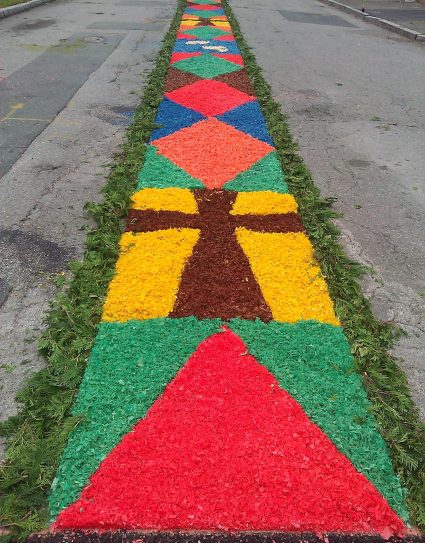
There was also no denying that I was hungry, and Mr. Farias’ old lady and old man had just the solution. Not only had they co-coordinated the decorating of the streets with the front-door neighbors for the better part of six years, but immediately following the procession their home became an open kitchen to family & friends, passers-by, and even the local funeral director and his ever-soliciting ways. From bacalhau (cod fish) and carne d’espeto (Portuguese beef skewers), to cacoila (marinated pulled pork) and rotisserie chicken à la Português; the options were plentiful, the outcome delectable. Two malasadas (Portuguese donuts) later I had departed my first Portuguese feast, and one afternoon later my girlfriend and I had departed back to Miami.
This past August 2014, I returned to the Senhor da Pedra Feast, only the morning routine was a little different. What was a previous vacation destination was now a place of abode, pillow-drooling was now directed at my girlfriend-turned-wife’s only pillow, and guest room late-night tiptoeing was no longer required.
But some things of course never change. The 8½” x 11” flyer contained the same verbiage, the red and green flags containing the round yellow emblems were as prevalent as ever, and Simon—formerly known as Mr. Farias—still mocked me for oversleeping. As for the dozen-and-a-half people, they were occupied reenacting their 2005 performance of the colors, but Simon still felt the need to once again remind them that his now son-in-law was Cuban. The demand for over-baked ‘pops’ remained steady; lukewarm draft beer was still served to the masses.
About 30 minutes after my arrival, Simon requested that I return home to obtain a notepad, as I had been marveling about the feast for years and vouching to one day write about it. The day had arrived.
With a yellow notepad in hand and pen on ear, I neared Eugenia Street as Zac Brown Band’s “Colder Weather” played from an undisclosed location on a New Bedford summer. Soon thereafter Simon and I were meeting on a familiar kitchen counter to briefly discuss the history of the feast and the proposed list of questions I should ask the front-door neighbors.
“Facts, get the facts,” Simon emphasized.
As our meeting neared its conclusion, I slightly bowed my head and glanced over to the living room couch and recliner, both of which were now unoccupied.
“Better make it a double,” I reminiscently asked Simon as he reached for the unmarked red ceramic bottle.
I exited the home and went across the street to assume my fact-seeking role, where I was met with open arms by Maria, Tina, and the rest of their lovely family. The information came fast and furious, so I did my best to capture it all via bullet points:
- The Senhor da Pedra feast originated in the 16th century in Vila Franca do Campo, a town in the Azorean island of São Miguel.
- On the last Sunday of August 1929, Azorean immigrants from the Vila Franca do Campo region commemorated the feast in New Bedford for the first time.
- The feast was suspended in New Bedford during the blackouts imposed during World War II, but João Amaral, Manuel Lazaro, and a few more good men revived the feast in 1959, at around which time Manuel Lazaro established the decorating of the streets tradition that we know today.
“So hold on, I thought it was your family that started the decorating of the streets tradition? “
I asked the lovely family in a puzzled manner.
“No, no, no,” responded one Tina DeMedeiros.
“My mother Maria and my late father joined in about 20 years ago. But it was Mr. Lazaro who started it decades ago, and his family and descendants keep the tradition alive till this day. They actually decorate the western portion of Eugenia Street, but instead of woodchips, they use a form of colored sand.”
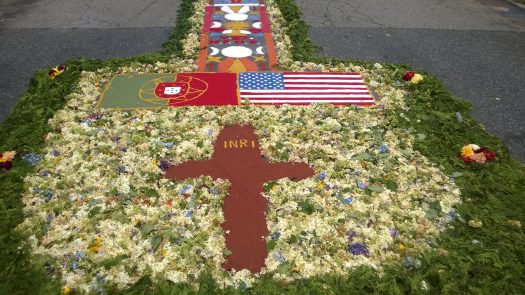
“But do you guys get along with them?” I asked, shamefully hoping there was some sort of friction between the two families to make my story “juicer.”
“Oh my god, yes!” Tina exclaimed without hesitation.
“We’re great friends. This is a full-on community endeavor. We’re all in it together. The goal is for the kids to keep the tradition alive.”
“My juicy story will come one day,” I thought to myself.
“As a matter of fact,” Tina continued, “same goes for your father-in-law’s family. When they bought their house just across from us about 15 years ago, they immediately teamed up with us and we’ve been decorating the street with woodchips ever since using the same wooden stencils that my brother-in-law Joe built 20 years ago.
Even some side-street neighbors have joined in on the action and created their own version of decorating the streets. But I have to speak with Joe.
It’s time for him to build some new stencils. Maybe next year. Oh, and did I tell you that we dye the woodchips right here in my yard two nights before the parade and that the eyes for the pigeon outlines come from your in-laws’ berry garden? And JJ? What a talent for colors that kid has. Designer, director; call him what you want.”
Facts, facts, facts; I was merely working as instructed, and back to my bullet points I went:
- The feast is hosted and organized by the Society of Senhor da Pedra, a non-profit organization which, among its other endeavors, assists local organizations of need.
- The feast is not just a Sunday affair. It actually begins on Friday with a sacred church service. On Saturday the Senhor da Pedra and Nossa Senhora das Dores (Our Lady of Sorrows) statues are moved from the local immaculate conception school to the local immaculate conception church. And on Sunday is when you have the procession. All three days conclude with live musical acts and a variety of foods.
My notepad was littered with chicken scratch and I was beset with information overload. It was time to say my goodbyes to the lovely family.
“And feel free to speak to my husband David if you need additional information; he’s the real expert,” uttered Tina, as I walked back towards Eugenia Street.
Two hours later the procession of believers had embarked upon Eugenia Street and disarranged the woodchips and sand set upon it, and 25 minutes later the New Bedford Department of Public Works had restored the street to the City’s original color selection, asphalt gray.

“Heyyy, moron, did you speak with Tina?” shouted my father-in-law, as he caught a glimpse of me as the crowds dispersed.
“Oh yeah, Simon, and I’ve got the facts.”
The 2014 Senhor da Pedra Feast was officially in the books, and the lack of paint under my fingernails—now replaced by pen marks—was a clear indication that I had attended the feast in a different capacity than in 2005. So different, in fact, that I didn’t even get to visit my alma mater, Eugenia U.
And as I proceeded to walk home and continue reflecting about the things that had changed over a nine-year period, I saw Maria Maucabelo, Tina’s mom, through my peripheral vision sitting alone on her front porch. She had already answered some of my questions from earlier in the day and I had repeatedly expressed my sincere appreciation to her, but I figured that a final ‘thank you’ couldn’t hurt. So I approached the front porch to tell her “obrigado,” which led to a brief conversation. I began speaking to her in my “conversational” Portuguese, which consists of speaking Spanish slowly in as nasal-sounding of a manner as possible. Let’s just say we understood each other “mais ou menos.”
But despite a roughly 50% comprehension rate, I was able to discern the one phrase she continually emphasized:
“Esta festa é para todos.”
Simple enough, I thought to myself. Spanish and Portuguese share striking similarities in dialect, and even I could understand Ms. Maucabelo’s assertion that the Senhor da Pedra feast is for everybody.
And who could disagree, right? As I had seen in 2005 and again in 2014, the feast was attended by men and women, kids and seniors, friends and strangers; you name it. The same notion seemed to apply to people of different races and ethnicities. Heck, I’m Cuban and the two barricades closing off Eugenia Street couldn’t have been placed there to keep me out, right? And what about Tio Sam’s wife, Antonia? She is Cape Verdean, a woman of dark complexion, and surely no one seemed to be messing with the black woman.
But what about the fact that the annual feast, without fail, is always attended by predominantly Portuguese persons of light complexion? Well, that could be reasonably attributed to the fact that more than 47 percent of New Bedford’s population is from Portugal or of Portuguese descent, and let’s not forget, the Senhor da Pedra feast did originate, after all, in Vila Franca do Campo.
So by all accounts, Ms. Maucabelo was right; this feast is for everybody. In essence, and despite all of the facts that my father-in-law insisted I gather, I could have written this same story back in 2005, one which boils down to a feast that strives to a) keep a rich tradition alive and b) accept people of all backgrounds without regard to ethnicity or color.
But as my conversation with Ms. Maucabelo was coming to an end, I looked up toward Eugenia Street, envisioned it as it was just before the arrival of the Department of Public Works employee, and pondered a question that was beyond my “conversational” Portuguese capabilities:
“Ms. Maucabelo, with all due respect and solely for purposes of clarification, are you sure this feast is also for the color-blind?”
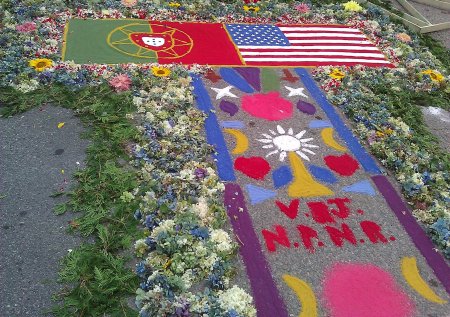
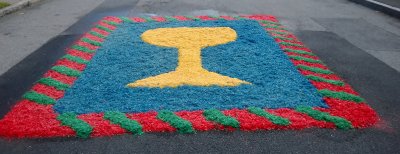
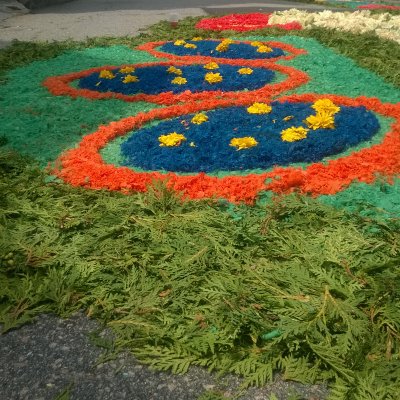
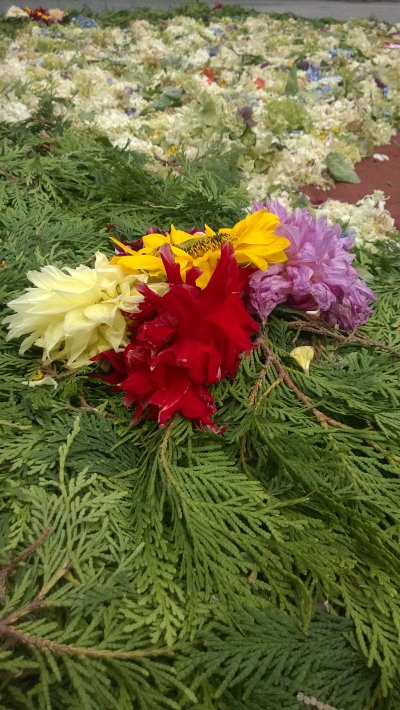
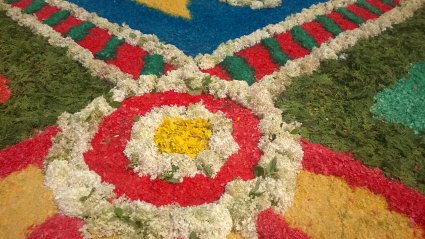
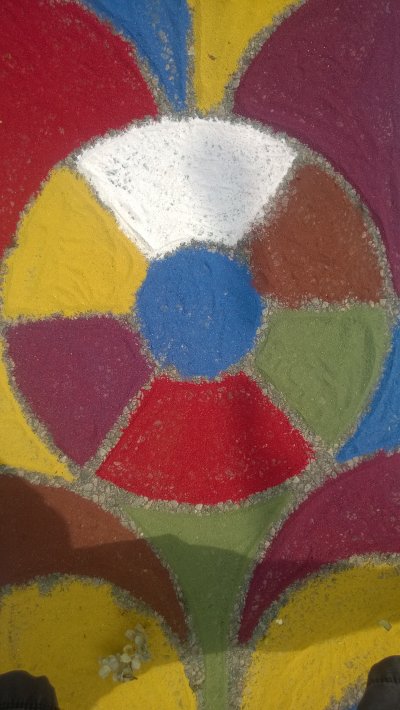
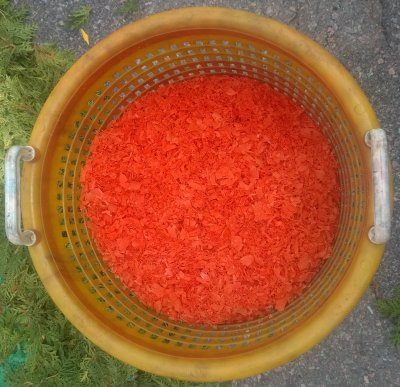


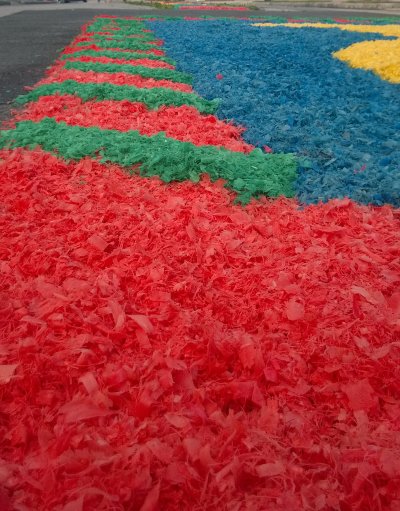
This story is dedicated in memoriam to Maria Auxiliadora (Borges) Farias & Jose de Farias (the ‘old lady’ and the ‘old man’), Diamantina (Tina) Cardoso, Arlindo M. Moura, and Antonio (Suica) Pacheco Faria, all of whom not only played a special role in my life, but also helped shape the way I view the Senhor da Pedra Feast through the present day. It is also dedicated in memoriam to Eduarda Correia, who welcomed me with open arms when I interviewed her and her family and is surely missed.
To read more of Josmanny’s work, visit his personal blog at: jhorta.wordpress.com
 New Bedford Guide Your Guide to New Bedford and South Coast, MA
New Bedford Guide Your Guide to New Bedford and South Coast, MA





